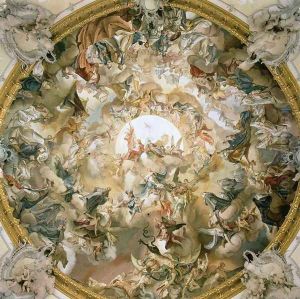Matthaus Gunther Paintings
Matthäus Günther was a prolific Rococo painter and fresco artist who made significant contributions to Southern German and Central European art in the 18th century. Born on September 7, 1705, in Peißenberg, Bavaria, Günther was initially trained by his father, who was a painter. He further honed his skills in Augsburg under the tutelage of Johann Georg Bergmüller. In addition to his apprenticeship, Günther also studied at the Academy of Fine Arts Vienna, which was an important center for artistic training at the time.
Günther's work is characterized by its dynamic compositions and vibrant colors, typical of the Rococo style, which emphasized ornate detail, asymmetry, and pastel colors. His frescoes and altarpieces are found in many churches in Southern Germany, Austria, and Bohemia. One of his most notable works is the ceiling fresco of the Wieskirche, a UNESCO World Heritage site. The church is a masterpiece of Rococo architecture and Günther's fresco contributes to its heavenly and festive atmosphere, portraying scenes from the New Testament.
Throughout his career, Günther received numerous commissions from religious institutions, which were the main patrons of art at the time. His work was not limited to religious themes, however; he also painted mythological scenes and contributed to the decoration of various secular buildings. Günther's influence extended through his teaching at the Augsburg Academy, where he instructed many students who would continue the Rococo tradition.
Matthäus Günther's artistic legacy is marked by his successful integration of Bavarian Rococo sensibilities with the broader European art movements of his time. His frescoes, in particular, are celebrated for their illusionistic qualities and the sense of motion and life they bring to the architecture they adorn. Günther passed away on August 18, 1788, in Augsburg, leaving behind a rich body of work that continues to be studied and admired for its artistry and historical significance.
